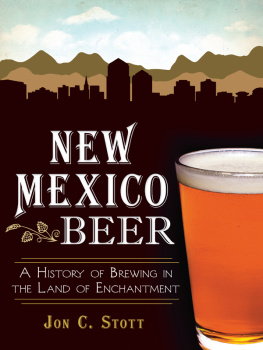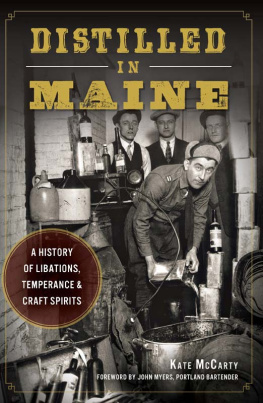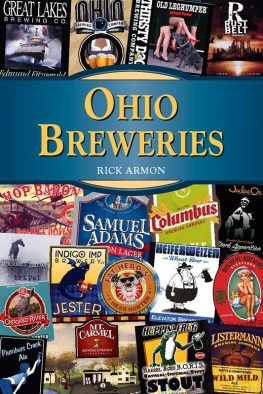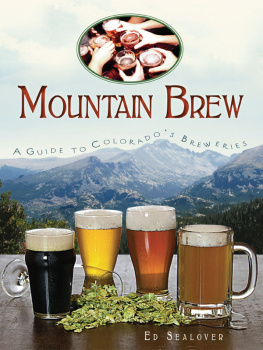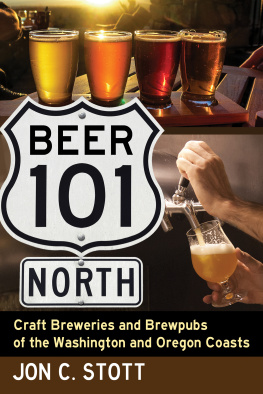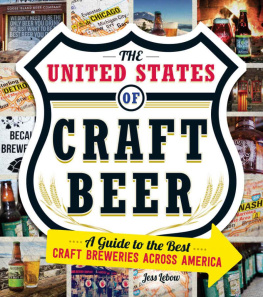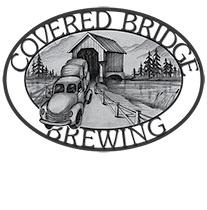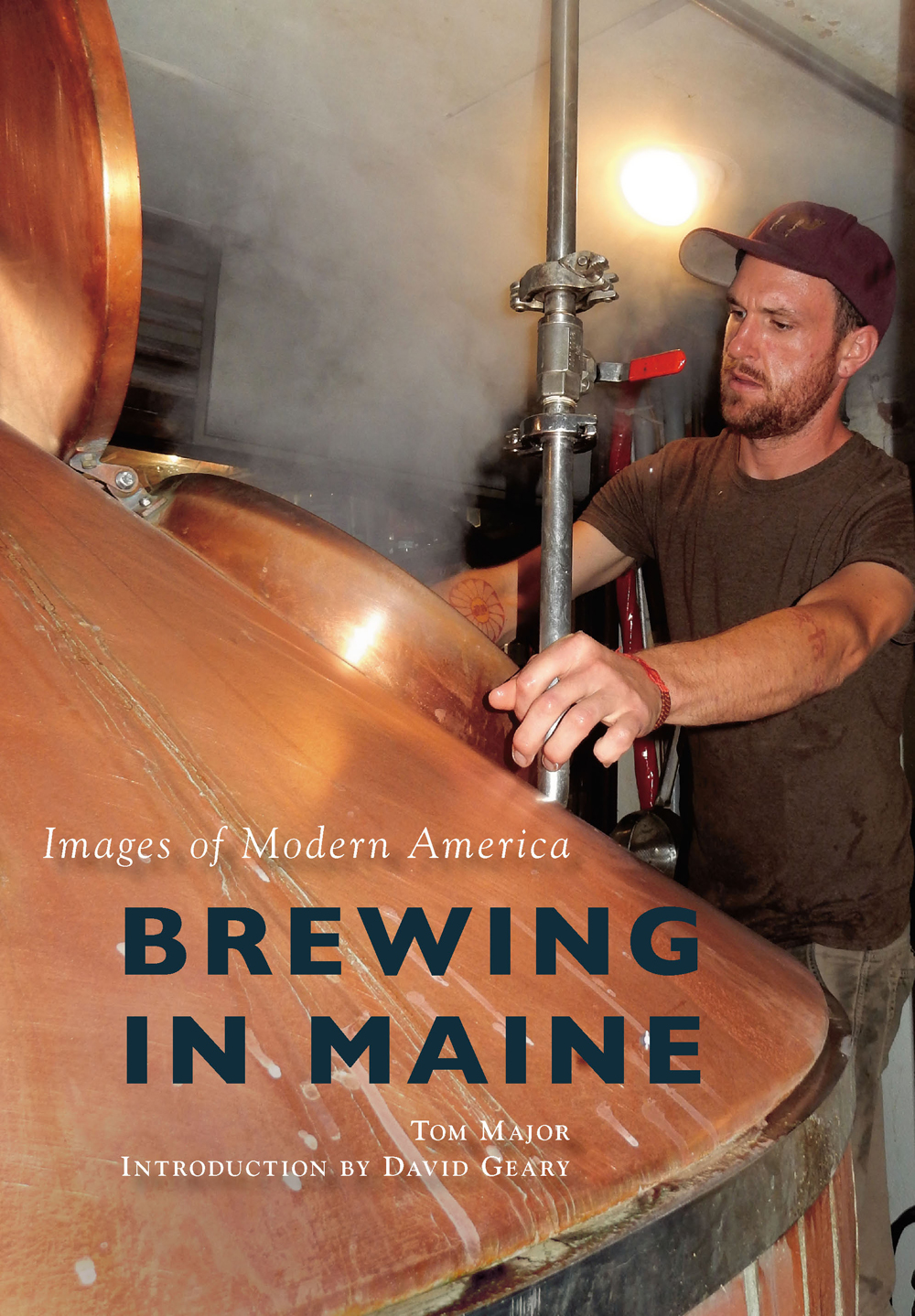
Images of Modern America
BREWING
IN MAINE

With more than 50 breweries in Maine, brew bus services have made touring more accessible, safe, and fun. The Maine Brew Bus, shown outside the Foundation and Bissell Brothers breweries, and the Maine Beer Tours both began operating in 2012, serving the southern Maine area from their bases in Portland. The Growler Bus began serving the Bangor-area breweries in 2015. (Authors collection.)
FRONT COVER: Shane Noble, brewer at Gritty McDuffs in Portland (Authors collection)
UPPER BACK COVER: Gritty McDuffs Freeport Brew Pub (Authors collection)
LOWER BACK COVER: (from left to right) Stasia Brewczynski (Photograph by Kevin Farnsworth, courtesy of Rising Tide Brewing Company), Novare Res Bier Cafes Shahin Khojastehzad (Artwork by Ryan Adams), and David Geary and Alan Pugsley (Courtesy of Great Lost Bear)
Images of Modern America
BREWING
IN MAINE
TOM MAJOR
INTRODUCTION BY DAVID GEARY

Copyright 2016 by Tom Major
ISBN 978-1-4671-1569-8
Ebook ISBN 9781439656327
Published by Arcadia Publishing
Charleston, South Carolina
Library of Congress Control Number: 2015951132
For all general information, please contact Arcadia Publishing:
Telephone 843-853-2070
Fax 843-853-0044
E-mail
For customer service and orders:
Toll-Free 1-888-313-2665
Visit us on the Internet at www.arcadiapublishing.com
In Memoriam John E. Major
19332002
CONTENTS
ACKNOWLEDGMENTS
No book is a solitary endeavor. More folks have contributed to this work than I can list on one page. I am indebted to them all but must mention some by name. Sean Sullivan recommended me for this assignment and encouraged me throughout. Cheers! Caitrin Cunningham and the good folks at Arcadia Publishing showed exceptional patience at every stage. Prost! Countless brewers, writers, artists, and tapsters took time from their work to help me. Na zdrav! Many folks dug into their file cabinets and hard drives for old photographs, especially Dave Evans, whose archives are unrivaled. Uncredited photographs throughout the book are mine, but I thank all the folks who provided all those credited photographs. Cin cin! Chris Maria and the Kenneth Street Brew Crew shared long memories of beers and bars. Keskun! Nick Ludington was an intrepid and patient research assistant and guide to the Mid Coast. Serefe! Eric Roux gave me my first jug of homebrew (or at least ignored us when his brother and I swiped it). Sant! Joseph Conforti, Kent Ryden, Libby Bischof, and Adam Tuchinsky honed my research skills and sharpened my focus. Saluti! Pete Small, Kelli Deveaux, and Elise Dunphe have helped in all sorts of ways. Kanpai! Stephan Chase and Doug Mayo gave me tutorials about commercial culture and the art of the brand, but even more valuable are their decades of friendship. Yasou! Skl!
Most of all, I thank my family members who have indulgently listened to me talk too much about beer. I thank the Inmans, Linnells, Shapiros, Mahoneys, Fletchers, Hardys, Majors, and Lorellos for always being in my corner. Lchaim! I thank my mom, who always believed that I would be a writer; my brother Michael, who gave me my first Miller High Life and my first Grolsch; my sister Janice, who guided me through the breweries of York County; my son Noah, who alone tries to temper my obsessive prattling (Brettanomyces, blah, blah, blah); and most of all, my wife, Jennifer, who has lightened my every burden and deserves much credit for any success I have achieved. Slainte!
INTRODUCTION
Since the dawn of agriculture, people have been making beer. Virtually every culture on earth has a brewing history. It is what we do as a species. We ferment. The earliest known depiction of two guys having a beer is on Sumerian clay tablets from 1800 BC. The tablets also include A hymn to Ninkasi, which details the process from grain to fermentation.
The fermentation process was little understood until the 19th century when Louis Pasteur detailed the role of yeast and bacteria in the process. Until that time, it was considered a blessing. In fact, the Middle English word for yeast is goddisgoode.
I began my brewing journey more than 30 years ago when I met Peter Maxwell Stuart, the 20th Laird of Traquair. He was brewing beer in a restored 17th-century brewery at Traquair House in Innerleithen, Scotland. He was exporting a small amount to the United States and was in Portland to meet with importer Alan Eames, the founder of Three Dollar Deweys.
Stuart and I had a few meals together, and he talked at length about commercial brewing on a small scale. He suggested that I should consider doing it as well, and that he would welcome me to Traquair to work and learn. Two months later, I found myself on a flight to the United Kingdom.
I stayed at Traquair for a month, brewing, reading, and learning. The brewing vessels were made of oak from Lithuania, and the floor was stone. At the end of my stay, Stuart made telephone calls arranging apprenticeships in a half dozen breweries from Scotland to the south coast of England. Included were Belhaven Brewery in Dunbar, Strathalbyn in Glasgow, Bass in Burton upon Trent, and two brewpubs in London. At my last stop, Ringwood Brewery in Hampshire, I met Alan Pugsley and asked if he would consider working with me in Maine, assuming that I could put it all together. He smiled and said that he would. Peter Austin, Ringwoods owner and brewmaster, was also in the business of designing and fabricating small breweries. I brewed many times with the Peter Austin system (under the watchful eyes of Austin and Pugsley), so when the time came to commission a brewery, it made a lot of sense to go with the Austin system.
When I returned home, I started work on a business plan. There were only a handful of so-called microbreweries in the country at the time, but I got a lot of guidance from them in finding packaging, equipment, bottles, and fabricators.
Once the plan was complete, I started making calls to sell my idea. Trying to sell an idea that no one had ever heard of was a challenge to say the least. The reactions ranged from hasty rejections to laughter, but finally, we had the help we needed.
We began construction in 1986 and sold our first kegs of Gearys Pale Ale in December of that year. When we started bottling, we made the rounds of retailers to make placements. For the most part, people embraced the idea, but our big break came when two supermarket chains mandated it for all their stores. There it was, one lonely six-pack sitting on a shelf in the cooler among the Buds, Millers, and a few imports. A couple of years later, Samuel Adams came to Maine, and we had a category!
Over the next decade, the craft brewing industry grew at a modest rate. In 1999, a correction took place in the market, and a significant number of breweries closed. I have a poster from 1987 showing the labels of most of the craft brewers in the country at the time. By 1999, approximately 50 percent of them had closed. The reasons were the usual culprits in any business: quality issues and profitability.
By 2009, that trend had reversed dramatically. Scores of breweries were opening all over the country, and openings were increasing exponentially. By the summer of 2015, there were 3,500 craft breweries operating in the United States. This has created obstacles and opportunities in the industry.
Next page

